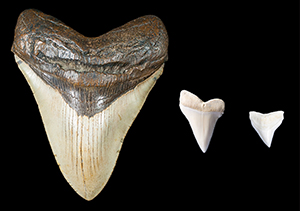Crossref Citations
This article has been cited by the following publications. This list is generated based on data provided by
Crossref.
Mojetta, Angelo R.
Travaglini, Andrea
Scacco, Umberto
and
Bottaro, Massimiliano
2018.
Where sharks met humans: The Mediterranean Sea, history and myth of an ancient interaction between two dominant predators.
Regional Studies in Marine Science,
Vol. 21,
Issue. ,
p.
30.
Lowry, Dayv
and
Larson, Shawn
2019.
Sharks in Mexico: Research and Conservation Part A.
Vol. 83,
Issue. ,
p.
1.
Charpentier, Vincent
Adnet, Sylvain
and
Cappetta, Henri
2020.
The tooth of a giant sea creatureOtodus(Megaselachus) in the material culture of Neolithic maritime hunter‐gatherers at Sharbithat (Sultanate of Oman).
International Journal of Osteoarchaeology,
Vol. 30,
Issue. 6,
p.
835.
Martínez-Candelas, I.A.
Pérez-Jiménez, J.C.
Espinoza-Tenorio, A.
McClenachan, L.
and
Méndez-Loeza, I.
2020.
Use of historical data to assess changes in the vulnerability of sharks.
Fisheries Research,
Vol. 226,
Issue. ,
p.
105526.
Paris, Elizabeth H.
Bravo, Roberto López
Pacheco, Ellen
and
George, Miranda
2020.
Hunting, husbandry, exchange and ritual: animal use and meaning at Moxviquil, Chiapas Mexico.
Anthropozoologica,
Vol. 55,
Issue. 4,
p.
43.
Gilson, Simon-Pierre
Gates St-Pierre, Christian
Lominy, Martin
and
Lessa, Andrea
2021.
Shark teeth used as tools: An experimental archaeology study.
Journal of Archaeological Science: Reports,
Vol. 35,
Issue. ,
p.
102733.
Rubio‐Cisneros, Nadia T.
Martínez‐Candelas, Ilse A.
Ordaz‐García, Diana
Pérez‐Jiménez, Juan C.
Jiménez‐Cano, Nayeli G.
Glover, Jeffrey B.
Montes‐Ganzon, Brianna K.
Ruiz‐Ayma, Gabriel
and
González‐Rojas, José I.
2023.
Interdisciplinary science and fishers’ local ecological knowledge of sawfishes in the Yucatán Peninsula.
Aquatic Conservation: Marine and Freshwater Ecosystems,
Vol. 33,
Issue. 9,
p.
897.
Salazar Lama, Daniel
2023.
Dramatis personae del programa escultórico de la Subestructura IIC de Calakmul / Dramatis personae of the sculptural project of Calakmul's Substructure IIC.
REVISTA TRACE,
p.
188.
Newman, Sarah E.
and
Rossi, Franco D.
2023.
THE FOX AND THE ARMADILLO: AN INQUIRY INTO CLASSIC MAYA “ANIMAL” CATEGORIES.
Ancient Mesoamerica,
Vol. 34,
Issue. 2,
p.
360.
Prieto, Gabriel
2023.
Shark fisheries during the second millennium BC in Gramalote, north coast of Peru.
The Journal of Island and Coastal Archaeology,
Vol. 18,
Issue. 2,
p.
165.
Jiménez Cano, Nayeli G.
2023.
ANIMAL PROVISIONING AT CHICHEN ITZA AND ISLA CERRITOS: A ZOOARCHAEOLOGICAL REVIEW OF FAUNAL UTILIZATION.
Ancient Mesoamerica,
Vol. 34,
Issue. 2,
p.
509.
Pool, Christopher A.
Peres, Tanya M.
and
Loughlin, Michael L.
2024.
Settlement and the exploitation of aquatic resources in the Eastern Lower Papaloapan Basin, Veracruz, Mexico.
The Journal of Island and Coastal Archaeology,
Vol. 19,
Issue. 3,
p.
525.
